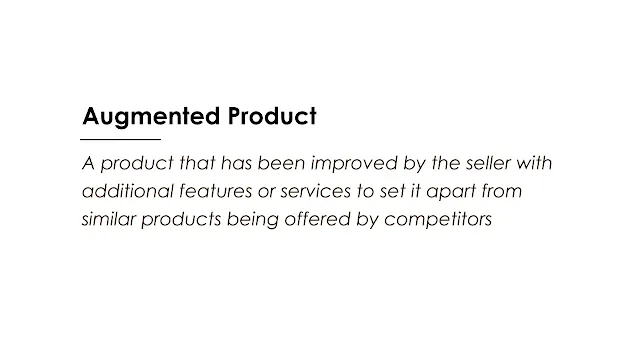 |
| Image: Moneybestpal.com |
An augmented product is a product that has been improved by the seller with additional features or services to set it apart from similar products being offered by competitors.
A product can be enhanced by adding extra features or benefits that are not directly related to the product itself. Free delivery, in-home installation, an extended warranty, customer support, reward systems, etc. are a few examples of the features that can be employed to develop augmented products.
Every product has at least three different versions: the core, the actual, and the augmented, which forms the basis of the idea of the augmented product. The value or advantage that the client derives from utilizing the product, not the actual item itself, is the core product. For instance, a car offers transportation, a smartphone offers communication, a lipstick offers attractiveness, etc.
The tangible item that the buyer purchases is the actual product, which includes its design, packaging, branding, quality, features, etc. A car, for instance, has a particular model, color, size, engine, etc. The augmented product increases the actual product's appeal, value, and customer satisfaction by adding features and services. For instance, a car might include free maintenance, towing, insurance, etc.
The purpose of augmenting a product is to give it a competitive edge and boost customer loyalty by offering extra value that the client might not anticipate or find in competing products. Adding features to a product can also help to support a higher asking price or develop the product's USP. While augmenting a product, the consumer experience and satisfaction are improved rather than the core or actual product itself.
Marketers must comprehend the needs, wants, expectations, and preferences of their target market in order to develop an effective augmented product. In order to differentiate their products from those of their rivals, they must also evaluate the offerings of those rivals.
The next step is for them to decide which augmentation features or services are the most pertinent and practical for improving their products and customers. Finally, they must regularly and successfully supply these features or services to their clients.
Some examples of augmented products are:
- Apple TV: In 2019, Apple debuted its streaming TV and video service. The business provided a free one-year subscription to anyone who bought an iPhone or another qualified device in order to raise awareness of the new offering and enhance iPhone sales. The streaming service and the gadget both gained value as a result, improving both offerings.
- Starbucks: Starbucks is renowned for its premium coffee goods, but it also provides a range of additional features that improve the loyalty and experience of its customers. Free Wi-Fi, mobile ordering and payment, individualized rewards programs, social responsibility programs, etc. are a few of these. Because of these characteristics, Starbucks is more than just a coffee shop; it is a trusted and favored lifestyle brand.
- Amazon Prime: Customers who subscribe to Amazon Prime get access to numerous advantages like free two-day shipping, limitless video and music streaming, exclusive offers and discounts, etc. These advantages increase the value of purchasing goods from Amazon, increasing the likelihood that customers will use the site more frequently and spend more money there.
In conclusion, an augmented product is a potent marketing tool that can assist marketers in differentiating their products, fostering consumer loyalty, and increasing profitability. Marketers can improve the value proposition and consumer experience of their products by incorporating features or services that go beyond the core or actual product.
